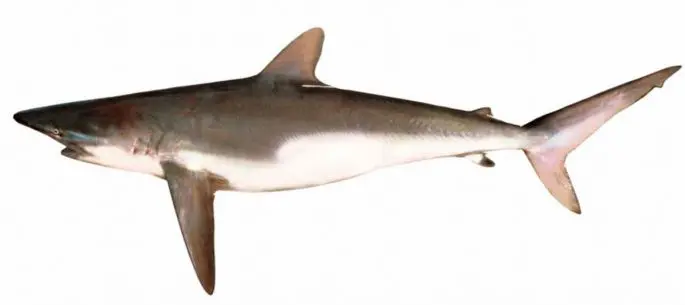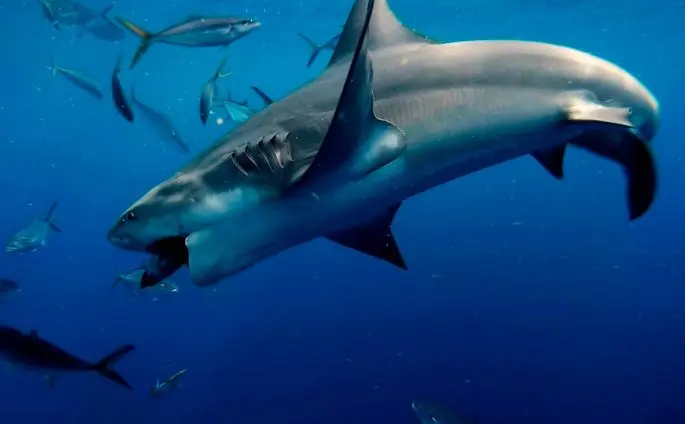Contents

Fishermen call the silky shark “net eater” among themselves. The shark is so preoccupied with chasing the tuna that it makes holes in fishing nets with ease.
Silk shark: description
This species of shark, which is also called the Florida, silky and broadmouth shark, was first introduced by German biologists Jacob Henle and Johann Müller in 1839. Since then, the shark has had the Latin name Carcharias falciformis, referring to the crescent-shaped pectoral and dorsal fins.
The “silk” predator got its name due to its silk-smooth skin. The surface of her body is covered with small placoid scales. Moreover, the size of these scales is so small that at first glance it seems that they do not exist at all. This effect is enhanced when the shark moves in direct sunlight. Then its body shimmers under the influence of direct sunlight in silver-gray tones.
Appearance, dimensions

The silky shark, like most predatory fish, has a slender streamlined body, while the shark’s snout is elongated and rounded with a barely noticeable skin fold in front. The predator’s eyes are round, small and have nictitating membranes. It is believed that the shark grows up to 2,5 meters in length, although there are specimens up to 3,5 meters long, which weigh up to 350 kilograms. The shark’s mouth is sickle-shaped, and there are shallow grooves in the corners of the mouth. The upper jaw is armed with strongly serrated triangular teeth with a special direction of growth. In the central part of the jaw, they grow at an angle of 90 degrees, and closer to the edges they are inclined towards the corners. On the lower jaw, the teeth are smooth, narrow and grow straight without changing their direction.
The silky shark has 5 pairs of medium-sized gill slits. The caudal fin is quite high, with a less pronounced lower lobe. The first dorsal fin ends slightly above the level of the upper lobe. Almost all shark fins are sickle-shaped, with the exception of the first dorsal fin. The ends of the fins have darker shades, which is especially pronounced in young sharks. Placoid scales are densely located on the surface of the skin. Each scale is distinguished by the fact that it has the shape of a rhombus, and at its end there is a kind of comb with a tooth.
The coloration of the back is dark gray or golden brown, and the belly has a classic white hue, while longitudinal stripes are visible on the sides. When a shark dies, its body quickly loses its silky glossy hue and turns gray.
Snorkeling with Silky Sharks.
Character and lifestyle

For its life, shark fish prefers the expanses of the world’s oceans. This predator is very active, curious and aggressive, although in terms of its level of aggression it is inferior to another predator that lives nearby – a more powerful, but slower long-winged shark. Silky sharks often flock together. Flocks are formed either depending on size or gender. You can also see such a picture: they open their mouths and turn sides to each other. At the same time, they stick out their gills. This means that a kind of disassembly began within the species.
An important point! When an object of interest appears in the shark’s field of vision, it begins to circle around it and only occasionally turns its head towards the object, as if demonstrating that it is not particularly interested in the object. She is also seen within sea buoys or logs, where she “winds” circles.
Experts noted that the shark has one oddity: from time to time it rises from the depths to the surface, after which it immediately turns around and rushes back at speed. So far, scientists cannot explain what this feature of behavior is connected with. Silky sharks can easily be seen among schools of other predatory fish, such as hammerhead fish, for example. At the same time, this type of shark, being in a flock of other predatory fish, pursues potential prey.
The shark poses a certain danger to humans, as it has an impressive size and rather sharp teeth. There are recorded cases of attacks by this shark on divers, but they are very few, since the silky shark rarely appears at shallow depths. This type of predator gets along well with such types of fish as pilot fish and caranis. The pilot fish loves to swim in the waves that are created when the shark moves, and the caranis feed on the remnants of its food, and also like to get rid of parasites, while they simply rub against the shark skin, covered with small scales.
How long does a silk shark live

Experts know that sharks living in warm and temperate climates have different life cycles. Thus, sharks representing warmer waters grow somewhat faster and become sexually mature faster. Despite this difference, the average lifespan of a silky shark is 22 and a half years.
natural habitats

The silky shark can be found in any part of the World Ocean, the water of which has a temperature of +23 degrees. In connection with the characteristics of life, experts distinguish 4 isolated populations, which represent different ocean basins. These include:
- Northwestern waters of the Atlantic.
- Eastern Pacific Ocean.
- The waters of the Indian Ocean, from Mozambique to Australia.
- Central and Western Pacific.
This type of predator prefers to hunt in the open waters of the oceans. At the same time, the shark is found both closer to the surface and at depths of more than 500 meters. As a result of observations, it was found that more than 90 percent of the time these sharks live at depths of about 50 meters.
Interesting to know! Silky sharks generally prefer to stick to island or continental shelves, or within coral reefs, which are located at depths. Sharks often enter coastal waters, the depth of which is about 18 meters.
This type of oceanic predators is characterized by high mobility and swiftness. They gather in flocks of up to 1 individuals and migrate over distances of up to 60 kilometers. At the same time, the migration of silk sharks is still poorly understood, but it is known that they can cover up to XNUMX kilometers per day.
What feeds on

Despite the fact that the expanses of the world’s oceans are immensity, there are not so many fish in them that the shark could eat without much effort and energy. High speed, endurance, as well as good hearing and a keen sense of smell help her find suitable schools of fish.
The shark is able to distinguish among the many signals propagating in the water column precisely those that indicate the detection of prey. Thanks to a keen sense of smell, the silky shark is perfectly oriented in the water column and quickly finds prey, which can be hundreds of meters away from the predator.
Interesting fact! This type of shark prefers to hunt tuna, but other types of fish, as well as cephalopods, are included in their diet. When hunting for fish, the shark drives the fish into dense schools and swims through them with its mouth wide open.
Therefore, despite the gastronomic preferences, the diet of silk sharks is:
- Sardine and horse mackerel.
- Mullet and mackerel.
- Sea bass and snappers.
- Katrans and glowing anchovies.
- Eels and mackerel.
- Spironogi and hedgehog fish.
- Squids, crabs and octopuses.
Within one place, several individuals can hunt at once, but each of them attacks its prey, not paying attention to relatives. The bottlenose dolphin is also included in the food chain of this predator. In addition, according to scientists, the shark does not disdain whale carcasses.
Reproduction and offspring

This type of shark is a viviparous variety. According to experts, the shark breeds throughout the year anywhere in the oceans, with the exception of the Gulf of Mexico. Here, the process of mating and childbirth is carried out at the end of spring or throughout the summer, until August.
Females can give birth, both every year and every other year, carrying future offspring throughout the year. Sexually mature females are distinguished by the presence of one functional ovary and 2 functional uterus, which are divided lengthwise into autonomous compartments that are intended for a particular embryo.
An important point! The fetus receives nutrition through the placenta, which is represented by an empty yolk sac. The peculiarity of the placenta is that the fetus itself and the mother’s body do not touch, unlike other viviparous species of sharks and mammals.
In addition, one more fact is noted: the erythrocytes of the mother are much larger than the erythrocytes of the cubs. In order for the offspring to be born, the female appears on the reef territories of the continental shelf, where there is enough food for the future offspring and a minimum of predators. No more than 16 shark cubs are born and, as a rule, their number is in the range of 6-12. During the first year of life, they add 0,2-0,3 meters in size. After a few months, young sharks leave their places of birth and go to the depths of the oceans.
The northern Gulf of Mexico has the highest growth rates for young stock, while off the coast of Taiwan, to the northeast, the slowest growth rates are noted. According to scientists, this process is associated not only with habitats, but also with gender. It has been proven that males grow much faster than females. In this regard, males have an earlier readiness for reproduction, compared with females. In males, this period occurs earlier, at least 1 year.
Natural enemies of the silky shark

It is quite natural that the silky shark can easily be the victim of a larger predator that lives in the expanses of the oceans. As a rule, these are larger sharks and killer whales. If they are in danger, they gather in flocks and thus can protect themselves from attacks by larger predators. If there is a duel, then the shark takes a threatening pose. She arches her back, raises her head and lowers her pectoral fins and tail. After that, the shark begins to move in circles, turning, all the while sideways to its opponent.
Population and species status

According to experts, silky sharks are becoming less and less every day. They associate this process with an increase in the scale of commercial production and the inability of the species to quickly recover. At the same time, it is also noted that not a small number of sharks die in the nets that anglers cast to catch tuna, which is the main food object of the diet of these sharks.
Many people hunt sharks for their fins, while considering the meat, skin, and blubber as by-products. In this regard, in many countries of the world this shark is considered a serious object for commercial and amateur fishing. According to the UN organization, in 2000 alone, about 11 tons of silk sharks were caught. After 4 years, according to the same organization, almost 3 times less was caught, and a similar negative trend can be traced in other reports.
Interesting to know! The authorities of Sri Lanka said that in 12 years, from 1994 to 2006, the catch of this oceanic predator decreased by almost 10 times, or even more, from 25 thousand tons to 1,96 thousand tons. As a result, significant damage was done to the local market.
For the sake of fairness, it should be noted that not all experts use the correct methods when determining the abundance of the silky shark, which lives in the northwestern waters of the Atlantic and the Gulf of Mexico. Japanese fishing companies operating in the Pacific and Indian Oceans in the 70s and until the 90s of the last century have not yet experienced a reduction in production.
Despite the data of experts, in 2007 the silky shark received the status of “close to vulnerable”. In some regions extending into the Pacific Southeast as well as the Atlantic Northwest, the shark has a “vulnerable” status.
Many conservation organizations hope that the fin clipping ban, which has already been adopted in Australia, the US and Europe, will be universally adopted. Two major organizations have developed a range of fisheries monitoring measures to reduce the number of fish caught in fishermen’s nets. These are organizations such as:
- Inter-American Commission for the Conservation of Tropical Tuna.
- International Commission for the Conservation of Atlantic Tuna.
At the same time, experts tend to argue that it is unlikely that it will be possible to develop effective methods to reduce by-catch. The fact is that silky sharks migrate in unison with migrations of tuna.
In conclusion

Despite the fact that the silky shark is a predatory fish that lives in the vast oceans, it requires protection, especially in our time, when fishing is especially active, despite many prohibitions and restrictions. Many types of fish suffer from this. The problem of preserving the number of many species of underwater inhabitants is also connected with the fact that fishing gear is constantly being improved. If earlier fishermen traveled hundreds of kilometers in the sea in search of shoals of fish, focusing on some signs of a natural character, now it is not difficult for them to find fish using technical means, for example, an echo sounder. This device not only indicates the depth to the nearest meter, but also shows not only single specimens, but also shoals of fish. Therefore, only a few remain without a catch, who are simply unlucky, and they ended up in the wrong place at the wrong time.









